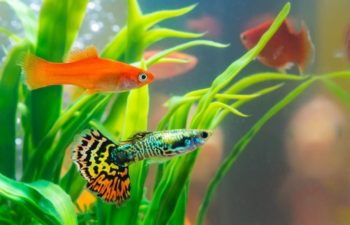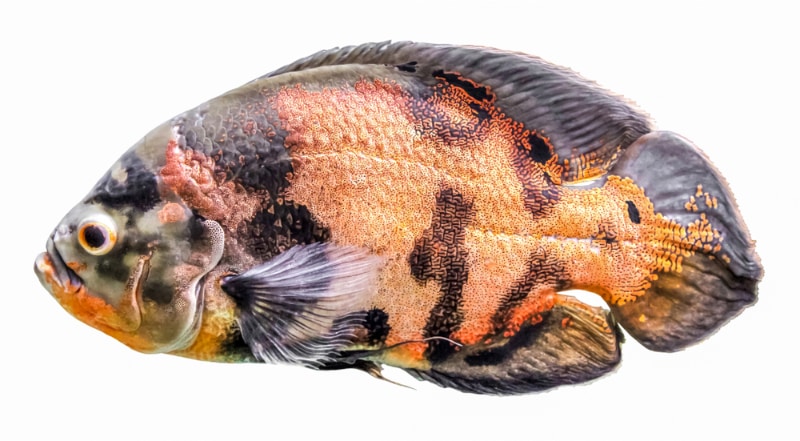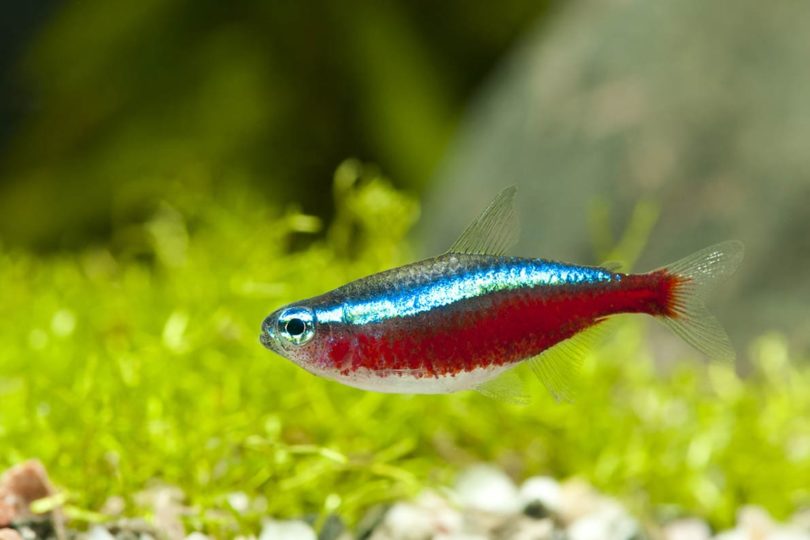Koi Angelfish: Care Guide, Types, Lifespan, Pictures & More
Updated on
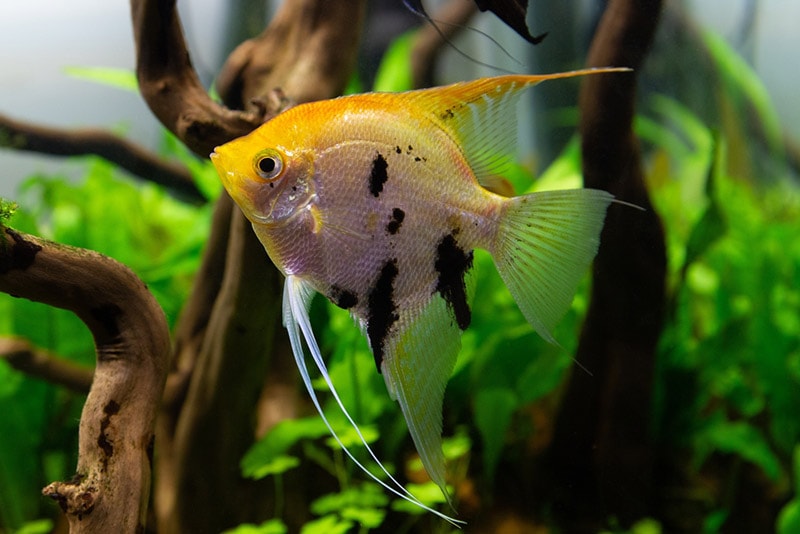
There are many varieties of angelfish, but the Koi Angelfish really stands out. Koi Angelfish have a stunning appearance with mottled colors and elongated bodies. These fish are a type of cichlid, but with a more peaceful and social temperament. If you are a beginner or novice fish keeper, then Koi Angelfish are worth considering for your aquarium.
Not only is their coloration unique in comparison to other angelfish varieties, but their temperament and size make them a great addition to both community and species-specific aquariums. Keep reading to find out more about the fascinating Koi Angelfish.

Quick Facts About Koi Angelfish
| Species Name: | Pterophyllum scalare |
| Family: | Cichlid |
| Care Level: | Easy to moderate |
| Temperature: | 75 to 84 degrees Fahrenheit |
| Temperament: | Semi-peaceful, social, territorial |
| Color Form: | Black, white, orange, red |
| Lifespan: | 10 to 12 years |
| Size: | 6 inches |
| Diet: | Omnivore |
| Minimum Tank Size: | 20 gallons |
| Tank Set-Up: | Freshwater and heated tank |
| Compatibility: | Community aquariums |
Koi Angelfish Overview
Out of the three recognized species of angelfish in the Pterophyllum genus, Koi Angelfish (P. scalare) is a type of freshwater angelfish that is kept as a pet and makes a popular addition to home aquariums.
They are native to South America where they inhabit the Amazon River Basin in Brazil, Peru, and Columbia. Since the angelfish’s natural waters are warm (tropical), slow-moving, and covered with dense vegetation, these conditions should be replicated in captivity if you want your angelfish to thrive.
The first angelfish in history was collected in Brazil by Hinrich Liechtenstein in 1823, and this fish was sent to a museum in Berlin where F. Schultze was the first to describe the species. Soon a second wild form of angelfish was found in the 1840s and given the scientific name Pterophyllum scalaris. The name was changed to P. scalare in the 1900s, and this was the beginning of the angelfish’s domestication.
Angelfish have since been kept in captivity for many years, and not all captive-bred angelfish are likely descendants of the wild-form angelfish. However, decades of selective breeding have altered the angelfish wild body form and led to the color mutations and different varieties of angelfish we keep as pets today.
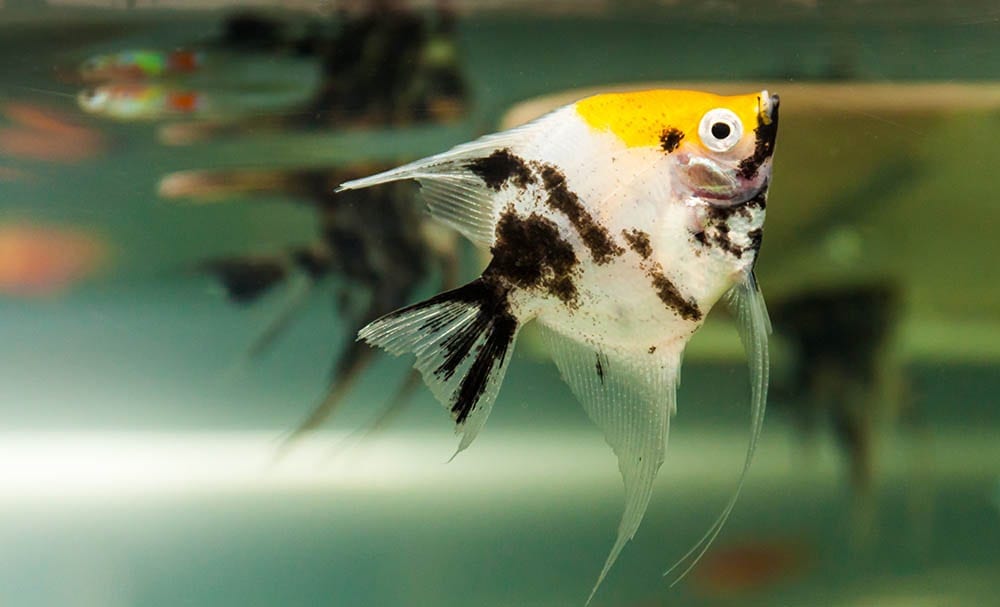
How Much Do Koi Angelfish Cost?
Even though Koi Angelfish fish may look rarer than other varieties, they are still not very expensive fish. Most pet stores will sell a Koi Angelfish for $10 to $40 depending on how large or old the fish is. Since Koi Angelfish are social and should be kept in groups, they aren’t going to be high priced since you need to buy more than one. If you were to buy a Koi Angelfish directly from a breeder, you should expect to pay a bit more.
Typical Behavior & Temperament
Most angelfish can be described as having a semi-peaceful and social temperament. They prefer to be kept in groups of 6 or more because they are social and school together in the wild. The Koi Angelfish can be aggressive, especially when they are kept with incompatible tank mates. The only time you may see an increase in your Koi Angelfish aggression is during the breeding season. Koi Angelfish can get quite territorial when breeding, so you might notice them chasing and fighting with other fish more than usual. In a school, the Koi Angelfish will establish a sort of hierarchy that can lead to the occasional chase or fin-nipping.
Koi Angelfish are diurnal, so they spend most of their day active and swimming around the top and middle part of the tank. You might find that Koi Angelfish are easily startled and can be quite shy when someone approaches the tank, especially when they are still small. When kept in large groups, angelfish seem to relax more and explore the tank without having to hide.

Appearance & Varieties
While the name might be misinterpreted, Koi Angelfish isn’t a type of koi fish at all. The word “koi” is used to describe a color strain of angelfish that resembles that of a Japanese koi fish. In terms of appearance, Koi Angelfish have a slender body that is elongated. Their dorsal fins are pointed, and their ventral fins are one of their most noticeable features.
Like all angelfish, the Koi Angelfish has long ventral fins, with the males being longer. Female Koi Angelfish generally have a smaller and more rounded belly, whereas males are larger with a bump on their foreheads. These fish grow around 6 inches in size, but older and well-cared-for Koi Angelfish may grow slightly larger.
Koi Angelfish have quite an interesting coloration, with a yellowish-orange patch on their heads and mottled white and black tri-colored bodies. Certain Koi Angelfish have more distinct patterns than others, but they all have a mixture of white, black, yellow, and orange. Their coloration is mottled, with patches of orange and yellow over a silver-white body. Koi Angelfish can either have a peppering of black or blotches of black on their bodies to complete the pattern.
How to Take Care of Koi Angelfish
Here’s how you can care for your Koi Angelfish:
Tank Size
The minimum tank size for a small group of Koi Angelfish is 20 gallons. However, as social fish, you should aim to keep them in larger groups of 6 or more. Due to the Koi Angelfishes’ swimming habits, vertical tanks are preferred over horizontal tanks. You should ideally keep your Koi Angelfish in a tank larger than 40 gallons if you want to observe their natural behaviors and keep them in suitable groups.
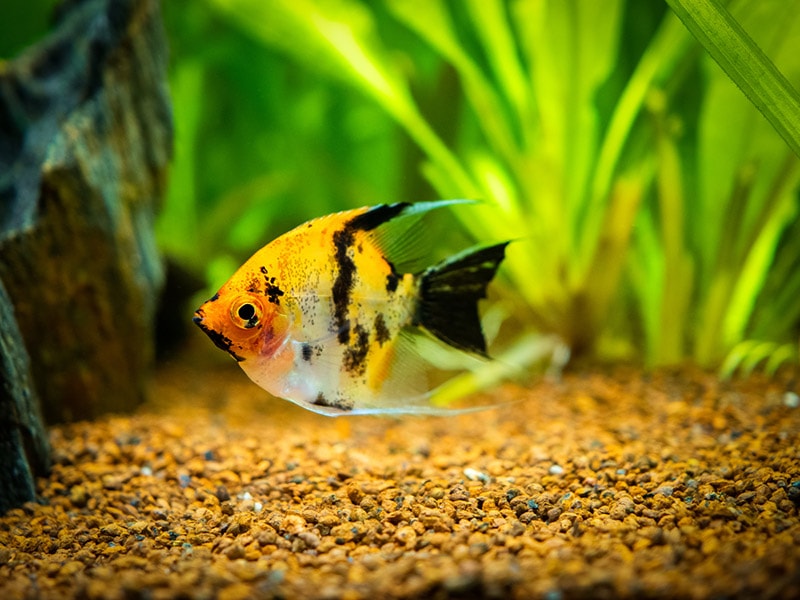
Water Quality & Conditions
Koi Angelfish can be sensitive to their water conditions, so ensuring that it meets their requirements is important. They are tropical and freshwater fish, which means that their tank needs to be equipped with a heater. This helps to keep the water warm and stable since room temperature can fluctuate. You should ideally keep the temperature between 75 to 84 degrees Fahrenheit. Angelfish aren’t very fussy over the water pH, so 6.5 to 7.1 is ideal.
Substrate
While Koi Angelfish don’t necessarily need a substrate in their tank, it will be useful in planted tanks. The substrate should not alter the water pH, so choosing sandy or fine gravel substrates will work well for angelfish.
Plants
Live plants are beneficial in a Koi Angelfish tank and create a natural environment. In the wild, angelfish spend most of their time swimming amongst the vegetation to feel safe and hide when necessary. Live plants such as Amazon swords, java fern, water sprite, and hornwort are preferred plants with angelfish.
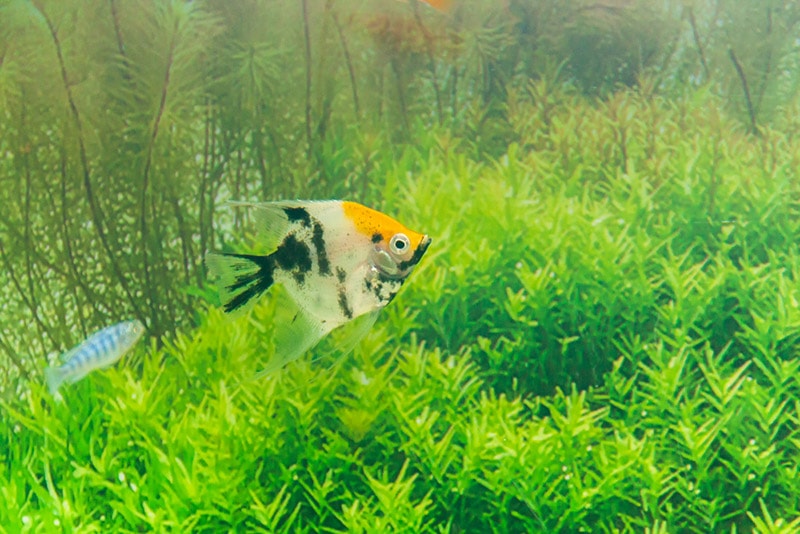
Lighting
Having a light over the Koi Angelfishe’s tank can simulate a day and night cycle, encourage plant growth, and enhance their colors. The light shouldn’t be too bright, as this can cause the angelfish to hide more often. A low to moderately bright light is recommended, and it should be kept on for 6 to 9 hours a day.
Filtration
To maintain good water quality in your Koi Angelfish tank, a filter is necessary. This will keep the water moving and prevent it from becoming stagnant while filtering out waste products. The filter should have a low current since angelfish don’t enjoy swimming in a tank with lots of flow. The filter should ideally cause enough surface movement to aerate the tank.
Are Koi Angelfish Good Tank Mates?
Koi Angelfish are quite popular in community tanks, and they seem to get along well with other tropical and non-aggressive fish. Any tank mates that you plan to keep with angelfish should be able to live in the same conditions to ensure that both fish can thrive. If you plan to add more fish into your Koi Angelfishe’s tank to create a community, then the size of the tank will need to be increased. This gives each fish plenty of space to swim normally and prevents overcrowded conditions.
- Corydoras catfish
- Plecostomus
- Dwarf gourami
- Ram cichlids
- Molly or platyfish
- Goldfish
- Koi
- Betta fish
- Oscars
- Blood Parrots
- Shrimp
What to Feed Your Koi Angelfish
Koi Angelfish will eat the same diet as other angelfish varieties. They are omnivores and benefit from a diet that contains both animal-based proteins and plants. A good tropical pellet or granular food formulated for angelfish will provide all the nutrients they need to stay healthy. You can feed your angelfish once a day and only enough food that they can eat within a few minutes. Koi Angelfish will benefit from supplements like bloodworms, brine shrimp, tubifex worms, and freeze-dried or live shrimp. The extra protein can help enhance their colors and help with growth in young angelfish.
Keeping Your Koi Angelfish Healthy
When provided with proper care and living conditions, the Koi Angelfish can live for 10 to 12 years. Keeping your Koi Angelfish healthy is fairly simple, and won’t take much time out of your day.
- Provide your Koi Angelfish with a large and filtered tank that is kept heated throughout the day and night. Do not let the temperature drop below 65 degrees Fahrenheit, since this is too cold for angelfish.
- Keep Koi Angelfish in groups of 3 or more, with the ideal starting number being 6. The more Koi Angelfish you keep together, the more active and less stressed they will be.
- Ensure that the tank’s water quality is good by keeping the ammonia and nitrite levels at 0 parts per million (ppm). Doing regular water changes and keeping the tank filtered can prevent any water quality problems.
- Feeding your Koi Angelfish a balanced diet will keep them healthy and help them maintain a good weight.
Breeding
It is quite simple to breed Koi Angelfish if you already have a sexually mature breeding pair. Koi Angelfish mature at 6 to 12 months and are ready to form pairs and breed. To encourage your Koi Angelfish to breed, you will need to gradually increase the temperature until it is between 80 to 85 degrees Fahrenheit. The tanks should be regularly maintained to keep the water extra clean during this time.
Most Koi Angelfish will form pairs on their own, and create a nesting site that they become territorial over. When the female is ready to spawn, she will lay hundreds of eggs that are then fertilized by the male. Most angelfish will protect the eggs and fry, but others (usually young breeding pairs) may begin eating them. If you find that your angelfish are eating their young, then relocating the eggs to a different tank can prevent this.

Are Koi Angelfish Suitable for Your Aquarium?
In comparison to other varieties of angelfish, the Koi Angelfish will make an interesting addition to tanks. They are relatively peaceful fish that enjoy swimming in large groups. They will be active during the day and rarely hide when kept in the right conditions. This means that you will have plenty of time to observe your Koi Angelfish and enjoy them in an aquarium.
Even though Koi Angelfish should be kept in groups of their species, you can keep them with compatible tank mates. With a healthy diet and good water quality, the Koi Angelfish will thrive in your aquarium and live for many years.
Featured Image Credit: Stefan Danila, Shutterstock


